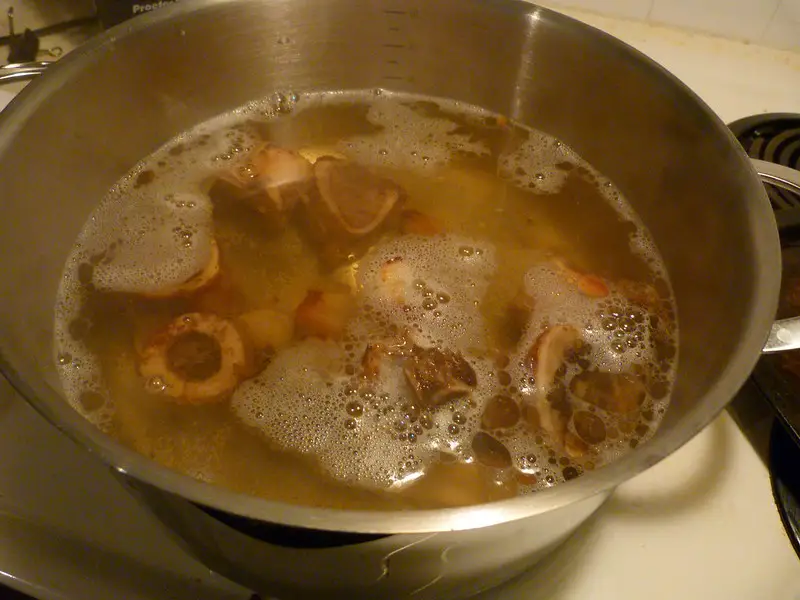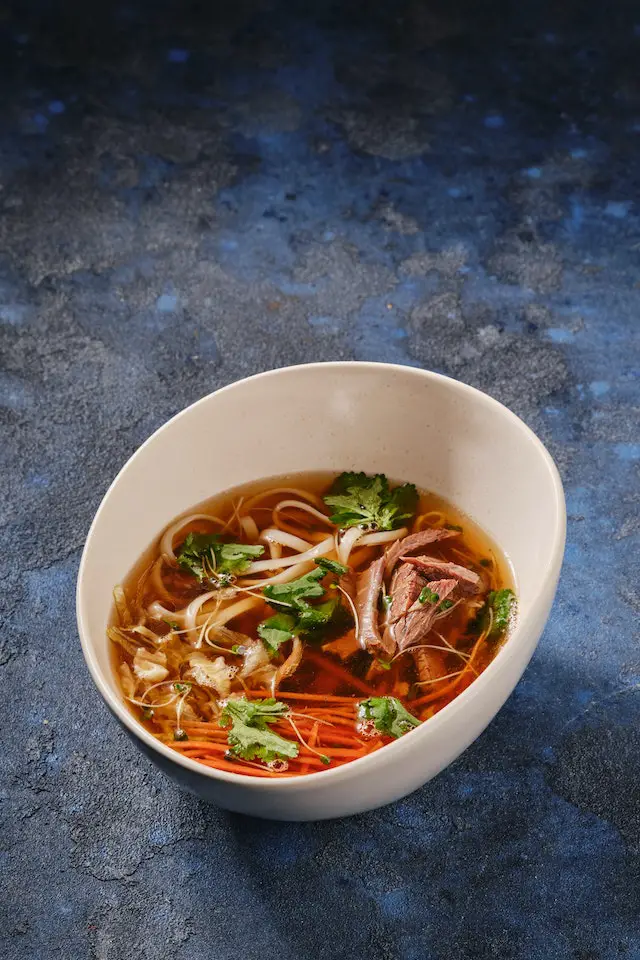Beef broth is typically made with meatier bones and is simmered for a shorter period of time, resulting in a lighter flavor that’s perfect for soups or gravies. On the other hand, beef stock is made by simmering more substantial bones for longer periods to produce a richer, more flavorful liquid that’s ideal as a base for stews and sauces.
What is beef broth?
(Photo By Anna Majkowska on Flickr)

Beef broth is a flavorful liquid made by simmering beef bones, vegetables, and herbs in water. It is typically cooked for a shorter time than beef stock, resulting in a lighter flavor and thinner consistency.
One of the key differences between beef broth and beef stock is that broth usually contains meat or meaty bones while stock does not. This means that broth has more protein content and can be used as an ingredient in soups, sauces, gravies or simply enjoyed on its own as a light soup.
Beef broth can also be made from leftover roast beef bones to enhance their flavor which makes it versatile to use up any leftovers you may have. When making homemade beef broth just remember to avoid adding too much salt since the natural sodium content of the ingredients will already provide enough seasoning.
Beef Broth’s delicate yet savory flavor profile makes it perfect for dishes where you don’t want to overpower other flavors but still want some depth.
What is beef stock?
(Photo By Rusty Clark ~ 100K Photos on flickr)

Beef stock is a flavorful liquid that’s made by simmering beef bones, vegetables, and herbs in water for an extended period. The slow-cooking process extracts the gelatin and collagen from the bones to produce a rich and hearty broth that can be used as the base for soups, stews, gravies, sauces or other dishes.
The ingredients of beef stock include meaty beef bones with marrow, onions, carrots and celery sticks with leaves. Other spices like thyme sprigs are also included. To make it more nutritious some people add ginger root or garlic cloves.
Unlike beef broth which is typically seasoned with salt and pepper for taste purposes alone; Beef stock has no seasoning added so that it can be used in recipes where you want complete control over flavorings.
Beef stock is versatile enough to pair well with different recipes such as French onion soup or pot-au-feu (a classic French stew), making it a staple ingredient in many kitchens around the world.
Beef broth Vs. Beef stock – Key differences
Beef broth and beef stock are two terms that are often used interchangeably. However, there is a key difference between these two ingredients.
Beef broth is made by simmering meat in water along with vegetables and seasonings. The result is a flavorful liquid that has a lighter consistency than beef stock.
On the other hand, beef stock is made by simmering bones (often with some meat still attached) in water along with vegetables and seasonings. The bones provide gelatin to the liquid which gives it a thicker consistency than broth.
Another difference lies in the cooking time – beef broth can be made within an hour or two while beef stock takes several hours of cooking to extract all the flavor and nutrients from the bones.
Because of their differences in flavor and consistency, they cannot always be used interchangeably in recipes. Beef broth works well as a base for soups, stews or sauces whereas beef stock works better when making gravies or risottos that require a thicker texture.
Both have their own distinct uses but understanding their differences will help you make informed choices when cooking your favorite dishes.
How to make beef broth?
Beef broth is a flavorful liquid that is made by simmering beef bones, vegetables, and herbs in water. Making beef broth at home isn’t difficult, but it does require some time and effort to get the best results.
To start making beef broth, gather your ingredients. You’ll need about 2-3 pounds of meaty beef bones such as oxtail or marrow bones. Roasting the bones beforehand will give your broth a richer flavor. Next, add chopped onions, celery, carrots and garlic to the pot with the bones.
Cover everything with cold water and bring it to a boil over high heat. Once boiling reduce heat to low so you are left with only gentle bubbles popping on the surface without breaking into rolling boil for next 6-8 hours till flavors infuse well.
After simmering for several hours strain out all solids using cheesecloth or fine mesh strainer.
Take off any fat from top now it’s ready! Beef broth can be used immediately or frozen for later use in soups stews or sauces
Making homemade beef broth might take some time but once you taste its rich flavourful taste -you’ll never go back again!
How to make beef stock?
Beef stock is a flavorful liquid that can enhance the taste of soups, stews, and gravies. Here’s how you can make your own beef stock at home:
Start by selecting high-quality beef bones with plenty of marrow and cartilage. You can use a mix of veal and beef bones for more flavor.
Roast the bones in the oven until they are browned on all sides. This will give your broth a rich color and deeper flavor.
Place the roasted bones in a large pot with water, celery, onions, carrots, garlic cloves, bay leaves and other herbs or spices to add more depth to your broth.
Bring everything to boil over medium-high heat then reduce it down low heat so it just simmers gently for 4-6 hours.
Skim off any foam or impurities that rise to the top during this time as these could ruin the final product’s taste.
Strain out solids using cheesecloth or fine-mesh strainer into another clean pot or container before storing it in jars once cooled down completely.
Homemade beef stock makes an excellent base for soups and sauces – try making some yourself today!
Can I substitute beef broth for beef stock?
If you are wondering whether you can substitute beef broth for beef stock, the answer is yes and no. It all depends on what you are preparing.
Beef broth is made by simmering meat, bones, and vegetables in water. It has a light flavor and is used as a base for soups, stews or gravies. On the other hand, beef stock is made by simmering mainly bones with some meat scraps and vegetables in water for an extended period of time until it becomes rich and gelatinous.
If your recipe calls for beef stock but you only have broth at home, keep in mind that the dish may not turn out as flavorful or rich as expected. However, if your recipe only requires a small amount of stock or if it’s meant to be more light-tasting such as clear soups or consommés then substituting with broth could work just fine.
Ultimately these two ingredients differ greatly when it comes to their richness of flavor so be mindful when making substitutions!
Which is healthier beef broth or beef stock?
When it comes to the health benefits of beef broth and beef stock, there are some key differences to consider. Both of them contain essential nutrients that can support your overall well-being, but one may be more beneficial than the other depending on your specific dietary needs.
Beef broth tends to be lower in calories and fat compared to beef stock. This makes it a great option for those who want to add flavor without adding excess calories or fat content. Additionally, beef broth is high in collagen which supports healthy skin, hair, nails and joints.
On the other hand, beef stock contains a higher amount of gelatin and minerals like calcium and magnesium which plays important roles in keeping our bones strong. It’s also worth mentioning that some brands of store-bought stocks and broths may contain added salt or preservatives that can negatively impact our health if consumed regularly.
When choosing between beef broth and beef stock for their nutritional value you should consider what your body needs most: fewer calories or bone-strengthening minerals?
Featured Image By – Kiro Wang








